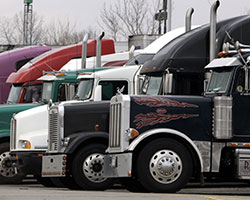<< Research Projects Overview << Year One Projects Overview
Truck Parking Study: Unveiling the Parking Space Density and Truck Volume Relationship - Phase I

Associate Professor, Zachry Department of Civil Engineering
Texas A&M University
bwang@civil.tamu.edu
Proposal Summary and Objectives
Truck parking has been a national concern for many years. There are several reasons behind it. One is that truck driving and on-duty hours are regulated by the federal law for the sake of traffic safety. Truckers cannot drive for more than 7 hours within any consecutive 24 hours of time. Truckers, especially those for inter-city travel, must find a resting spot when the driving hours reaches its federally enforced limit. Due to unavailability of truck parking space at locations, it is needed, truckers are often found to park illegally on highway ramps or other unsafe spots. Alternatively, some truckers are caught driving beyond the hours limit, which significantly contributes to the highway fatal rate.
The objective of this study is to study the relation between truck volume and parking space density in a simulation environment as phase I. The truck space availability issue is essentially one between volume and density subject to boundary conditions. The intuitive observation is that a higher volume demands more parking space statistically. The boundary condition is that there must be a minimum density no matter how low the volume is. In realistic situations such as those along the corridors of I-94 in Wisconsin and Minnesota as well as I-35, HW29 in Iowa and Texas, the team believes that there must be an inherent relationship between the space needed and the truck volume. The study means is a computer simulation, which allows to flexibly examining all different situations along the interstate highways in terms of volumes and density. The goal is to explore a statistical formula for this relationship in a hope that policymakers may use to examine the adequacy of truck parking space within their jurisdiction areas.
Funding Amount: $60,000
Status: Complete
Duration: Sept. 1, 2017 - Oct. 1, 2018